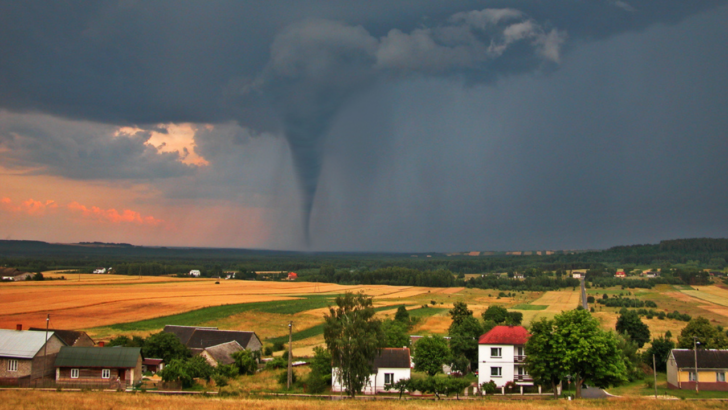Why do some years bring relentless droughts, unseasonal snow, or back-to-back hurricanes, while others don’t? As a Colorado Master Gardener and expert in agricultural engineering, I hear this question often.
Weather unpredictability can make gardening the ultimate challenge. You’ll question why your tomatoes were successful one year but not the next, or be left wondering if there will ever be any rain this year.
You’re not the only one. But to answer this question, we have to look thousands of miles away at weather phenomena in the tropical Pacific Ocean. That’s where the El Niño-Southern Oscillation, or ENSO, begins.
What is ENSO?
Though you may not realize it, ENSO is the puppet master behind many of the world’s seasonal climate patterns. ENSO impacts the number of hurricanes that we experience each year, the severity of droughts, the frequency of floods, and even wildfire risk.
ENSO is a natural climate pattern that shifts between three phases: El Niño (sea surface temperatures are warmer than average), La Niña (cooler-than-average sea surface temperatures), and ENSO-neutral (average temps between the two).
The phase of ENSO is primarily determined by sea surface temperatures in the east-central Tropical Pacific.
What is Our Current Climate Pattern for 2025?
According to the National Oceanic and Atmospheric Administration (NOAA), La Niña officially emerged in December 2024. However, experts from NOAA to the World Meteorological Organization warned from the beginning: this La Niña wasn’t built to last.
The ENSO Climate Forecast for the Rest of 2025
Given that La Niña has been relatively weak this past winter, weather forecasters from NOAA have been hedging their bets towards a shift in the dominant ENSO pattern from La Niña to ENSO-neutral.
However, an ENSO-neutral climate pattern doesn’t necessarily mean mild weather. Some of the worst droughts, floods, and hurricane seasons have occurred during ENSO-neutral years because climate change and other regional factors become the dominant weather drivers.
What to Expect in the Southern U.S.: Warm, Dry, and Growing Risk
La Niña typically brings warmer and drier conditions. This has been the case throughout the southern U.S., with areas like Texas and the Southeast experiencing rainfall deficits and unseasonably warm temperatures.
As La Niña continues to weaken towards ENSO-neutral, the worry is that ENSO won’t bring much relief. Southern states may stay locked in a dry, heat-prone weather pattern, increasing the risk of agricultural stress and early-season drought.
What to Expect in the Pacific Northwest and Mountain West: Moisture While It Lasts
During La Niña years, the Pacific Northwest and parts of the Mountain West typically experience cooler and wetter-than-average conditions, especially through winter and spring and in the northern Rockies.
As La Niña fades, these wet trends may fade with it. Spring should remain moist and mild in the Pacific Northwest, but early summer could tilt back toward normal or even warmer-than-average conditions. The Mountain West may trend drier and warmer than usual, especially in the southern portions of the region.
What to Expect in the Midwest and Northeast: Toss-Up Territory
In the central and northeastern U.S., ENSO’s influence tends to be weaker and less consistent. These regions are more sensitive to local environmental factors, like soil moisture.
Still, forecasters note that in transitional ENSO years:
- Late spring and early summer may feature above-normal warmth, especially if La Niña ends abruptly.
- Rainfall patterns are likely to be erratic, complicating planting and growing seasons.
- Severe weather in the Central Plains could spike due to increased temperature contrasts and lingering La Niña weather impacts.
What Does This Mean for My Garden?
In this upcoming growing season, it’s best to expect the unexpected. The shift from a weak La Niña to ENSO-neutral could herald all types of unexpected weather, from record-setting temperatures to extreme weather.
The best thing that you can do for your garden is invest in weather-resilient gardening practices. Resiliency isn’t just a trendy buzzword – building a climate-resilient garden can help your plants hold onto moisture when it doesn’t rain for weeks. It can help your peppers bounce back from a surprise hail storm (trust me, I’ve been there), and it enables your roses to shrug off a late-season cold snap with minimal damage.
“Climate change allows us to try new techniques, be flexible in our plant choices, and embrace seasonality in our garden spaces,” says Heather Prince, horticulturist at the Morton Arboretum in Lisle, Illinois. “Plants are incredibly resilient. They’ll surprise you.”
Interested in taking action to increase the resiliency of your garden? Consider the following steps that I think will take your gardening to the next level:
Step 1: Invest in your soil health
According to the University of Maryland, “Amending soil is not a one-time task. It’s a process of continuous improvement.” You can request a soil health test kit from your local extension office, or amend the soil you have by adding organic matter such as compost, aged manure, or worm castings to support a better soil ecosystem.
Step 2: Choose the right plants.
Native plants are perfectly suited to your local climate and are notoriously hardy to weather extremes. Perennials, another great option, are plants that live year after year, growing deeper roots and requiring less water once established. You can also look for crops labeled “heat-tolerant”, “drought-resistant”, or “disease-resistant” to select plants that have been developed to be more resilient to some of today’s most common agricultural challenges.
Marketmore cucumbers, for example, have been bred specifically to enhance their resistance to cucumber mosaic virus, downy mildew, and powdery mildew. Cornell University has a great list of disease-resistant vegetable varieties if you are looking for a place to get started.
Step 3: Smart water use
Exploring options such as drip irrigation, soaker hoses, and automatic watering systems ensure consistency in your garden during heatwaves and drought while minimizing your water loss.
Want to go low-tech? Ollas, a clay pot buried in the ground historically used by Indigenous populations, is an excellent option to keep your plants hydrated, according to the University of Arizona Cooperative Extension.
Step 4: Structure your garden for tough times
If your garden is going to survive the onslaught of 100-degree days, late-spring frosts, or hail, you’ve got to think beyond watering and weeding. Armor your garden with portable protection, such as covers, frames, and tunnels, to shield your plants from temperature swings, surprise hail storms, or pests. At a minimum, apply a heavy mulch layer to protect your soil, block weeds, and hold in moisture.
Be Prepared
If we can be sure of anything, it’s that gardening in 2025 may bring some unexpected weather-related challenges. So whether you dive in head-first and take action to make your garden more resilient, or you decide to wait and see what this year has in store, know that even one step can go a long way to help your plants survive and thrive in the face of the weather challenges to come.
Read more
Why a Rain Garden is a Good Idea for Your Yard (and the Planet)


